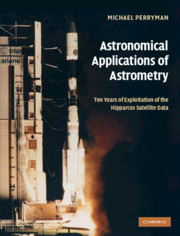Book contents
- Frontmatter
- Contents
- Preface
- 1 The Hipparcos and Tycho Catalogues
- 2 Derived catalogues and applications
- 3 Double and multiple stars
- 4 Photometry and variability
- 5 Luminosity calibration and distance scale
- 6 Open clusters, groups and associations
- 7 Stellar structure and evolution
- 8 Specific stellar types and the ISM
- 9 Structure of the Galaxy
- 10 Solar System and exoplanets
- Appendix A Numerical quantities
- Appendix B Acronyms
- Appendix C Author gallery
- Index of first authors
- Subject index
5 - Luminosity calibration and distance scale
Published online by Cambridge University Press: 23 November 2009
- Frontmatter
- Contents
- Preface
- 1 The Hipparcos and Tycho Catalogues
- 2 Derived catalogues and applications
- 3 Double and multiple stars
- 4 Photometry and variability
- 5 Luminosity calibration and distance scale
- 6 Open clusters, groups and associations
- 7 Stellar structure and evolution
- 8 Specific stellar types and the ISM
- 9 Structure of the Galaxy
- 10 Solar System and exoplanets
- Appendix A Numerical quantities
- Appendix B Acronyms
- Appendix C Author gallery
- Index of first authors
- Subject index
Summary
Introduction
Trigonometric parallaxes provide a distance measurement (essentially) free from model assumptions, at least at levels of order 1 mas. With Hipparcos parallax accuracies of σpi ˜ 1 mas, distances to individual objects at 10% accuracy are achieved out to ∼100 pc. In principle, the method can be applied to objects even at very large distances: the future ESA astrometric mission Gaia, with accuracies of some 10μas at V ∼ 10 mag, will measure distances of large numbers of sufficiently bright objects to 10% accuracy at 10 kpc. SIM PlanetQuest should exceed this by a factor of 10, reaching ∼1 μas for a reasonable number of bright objects. Parallaxes a further factor of 100 more accurate still, at around 10 nanoarcsec, would still be above the effects of interstellar and interplanetary scintillation in the optical, and above stochastic gravitational wave noise, and would in principle provide direct trigonometric distance measurements out to cosmological distances. Below 1 μas, however, stellar surface structure (Eriksson & Lindegren, 2007), and relativistic modelling (Anglada Escudé, 2007), may introduce significant barriers.
At the most basic level, knowledge of the distance to an astronomical object is necessary to convert its apparent properties such as magnitude or angular radius, to absolute quantities (luminosity and linear size respectively). In the absence of direct individual measurements, distance estimates must make recourse to various creative but less direct methods. Mean distances to groups of objects can be derived with higher formal accuracy using the Hipparcos data alone, notably to the Hyades open cluster at ∼45 pc and to the Pleiades open cluster at ∼120–130 pc, simply by averaging (or suitably weighting) a number of individual parallaxes.
- Type
- Chapter
- Information
- Astronomical Applications of AstrometryTen Years of Exploitation of the Hipparcos Satellite Data, pp. 207 - 272Publisher: Cambridge University PressPrint publication year: 2008



